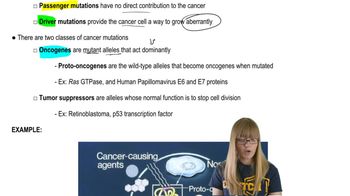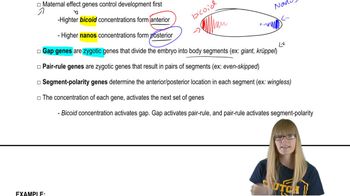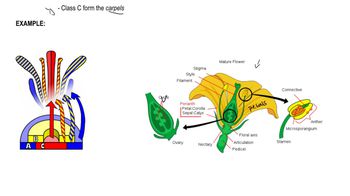Table of contents
- 1. Introduction to Genetics51m
- 2. Mendel's Laws of Inheritance3h 37m
- 3. Extensions to Mendelian Inheritance2h 41m
- 4. Genetic Mapping and Linkage2h 28m
- 5. Genetics of Bacteria and Viruses1h 21m
- 6. Chromosomal Variation1h 48m
- 7. DNA and Chromosome Structure56m
- 8. DNA Replication1h 10m
- 9. Mitosis and Meiosis1h 34m
- 10. Transcription1h 0m
- 11. Translation58m
- 12. Gene Regulation in Prokaryotes1h 19m
- 13. Gene Regulation in Eukaryotes44m
- 14. Genetic Control of Development44m
- 15. Genomes and Genomics1h 50m
- 16. Transposable Elements47m
- 17. Mutation, Repair, and Recombination1h 6m
- 18. Molecular Genetic Tools19m
- 19. Cancer Genetics29m
- 20. Quantitative Genetics1h 26m
- 21. Population Genetics50m
- 22. Evolutionary Genetics29m
14. Genetic Control of Development
Developmental Patterning Genes
Problem 20a
Textbook Question
A powerful approach to identifying genes of a developmental pathway is to screen for mutations that suppress or enhance the phenotype of interest. This approach was undertaken to elucidate the genetic pathway controlling C. elegans vulval development. In a complementary experiment, a gain-of-function let-23 mutant with a multi-vulva phenotype was also mutagenized. What types of mutations will suppress the multi-vulva phenotype?
 Verified step by step guidance
Verified step by step guidance1
Identify the role of the let-23 gene in C. elegans vulval development. The let-23 gene is part of the epidermal growth factor receptor (EGFR) pathway, which is crucial for proper vulval development.
Understand the nature of a gain-of-function mutation. A gain-of-function mutation in let-23 leads to excessive signaling, resulting in a multi-vulva phenotype.
Consider the genetic interactions that could suppress the multi-vulva phenotype. Suppressor mutations could occur in genes that are downstream or parallel to let-23 in the signaling pathway.
Focus on mutations that reduce or inhibit the overactive signaling caused by the gain-of-function let-23 mutation. These could include loss-of-function mutations in downstream effectors or negative regulators of the pathway.
Explore potential candidates for suppressor mutations, such as genes encoding proteins that negatively regulate the EGFR pathway, like phosphatases or other inhibitory molecules.
Recommended similar problem, with video answer:
 Verified Solution
Verified SolutionThis video solution was recommended by our tutors as helpful for the problem above
Video duration:
2mPlay a video:
Was this helpful?
Key Concepts
Here are the essential concepts you must grasp in order to answer the question correctly.
Gain-of-Function Mutations
Gain-of-function mutations result in a gene product with enhanced or new functions. In the context of the let-23 gene in C. elegans, such mutations can lead to a multi-vulva phenotype by overactivating signaling pathways involved in vulval development. Understanding these mutations is crucial for identifying how they can be suppressed by other genetic changes.
Recommended video:
Guided course

Functional Genomics
Suppressor Mutations
Suppressor mutations are genetic alterations that counteract the effects of a primary mutation, restoring the normal phenotype. In the case of the let-23 gain-of-function mutation, suppressor mutations may occur in downstream components of the signaling pathway or in genes that negatively regulate vulval development, thereby reducing the multi-vulva phenotype.
Recommended video:
Guided course

Cancer Mutations
Genetic Pathways
Genetic pathways are networks of genes that interact to control specific biological processes. In C. elegans vulval development, various genes work together to regulate cell fate decisions. Understanding these pathways is essential for predicting how mutations can influence phenotypes and for identifying potential suppressors of gain-of-function mutations.
Recommended video:
Guided course

Repair Pathways

 11:19m
11:19mWatch next
Master Segmentation Genes with a bite sized video explanation from Kylia Goodner
Start learningRelated Videos
Related Practice



